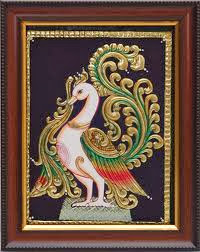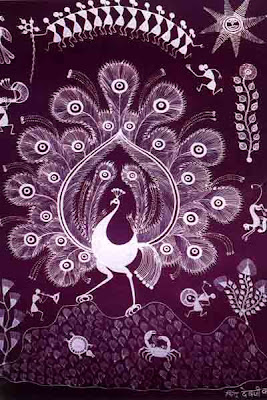It's time again to meet one more inspiring artist here on 3D. I met her during one exhibition, the stall that caught all my attention and I got lost looking at her fabulously done paintings was the stall of this wonderful artist who amazed each and every visitor by her excellent artwork. Please welcome Shilpa Singh, a woman of many talent. Over to Shilpa:
My name is Mrs. Shilpa Singh a homemaker and I do have interest in making Paintings and sketches. I make various kinds of paintings like:
Pencil Sketches where you sketch n shade with the help of pencils. This can be a portrait or any natural scene. Just black and white.
Madhubani painting is a style of Indian painting, practiced in the Mithila region of Bihar state. Madhubani paintings mostly depict the men & its association with nature and the scenes & deity from the ancient epic.
Orissa Paintings which depicts inspiration behind the Pattachitra Paintings is the beautiful ancient murals painted on the walls of temples.
Kangra Paintings finest art work from Himanchal Pradesh themes of eternal love between Radha and Krishna. Also, Kangra paintings depict the feminine charm in a very graceful manner. Beauty of female with sharp features and colorful dresses with pearl ornaments is the defined beautifully.
Lastly, Canvas Paintings showing great combinations of color with different figures relating mood and atmosphere.
Thank you so much Shilpa for sharing with us about your passion. I have seen all her paintings and I must say she is very talented artist on a multitude of levels and truly has an eye for detail.
Do you like her artwork then leave your comment below or shoot a mail at [shilpa_vimal_singh@yahoo.co.in] and she would be happy to answer your queries. She can create a piece of work especially for you. If you have something in mind just let her know and she will be ready to shape your dreams.
Have you met some more inspiring artists on my blog earlier...no then click here. Enjoy reading about artists and get inspired :)
.JPG)
Pencil Sketches where you sketch n shade with the help of pencils. This can be a portrait or any natural scene. Just black and white.
Madhubani painting is a style of Indian painting, practiced in the Mithila region of Bihar state. Madhubani paintings mostly depict the men & its association with nature and the scenes & deity from the ancient epic.
Orissa Paintings which depicts inspiration behind the Pattachitra Paintings is the beautiful ancient murals painted on the walls of temples.
Kangra Paintings finest art work from Himanchal Pradesh themes of eternal love between Radha and Krishna. Also, Kangra paintings depict the feminine charm in a very graceful manner. Beauty of female with sharp features and colorful dresses with pearl ornaments is the defined beautifully.
Lastly, Canvas Paintings showing great combinations of color with different figures relating mood and atmosphere.
Thank you so much Shilpa for sharing with us about your passion. I have seen all her paintings and I must say she is very talented artist on a multitude of levels and truly has an eye for detail.
Do you like her artwork then leave your comment below or shoot a mail at [shilpa_vimal_singh@yahoo.co.in] and she would be happy to answer your queries. She can create a piece of work especially for you. If you have something in mind just let her know and she will be ready to shape your dreams.
Have you met some more inspiring artists on my blog earlier...no then click here. Enjoy reading about artists and get inspired :)
.JPG)








.JPG)




.JPG)
















.JPG)











-crop.JPG)



.jpg)


-crop.JPG)